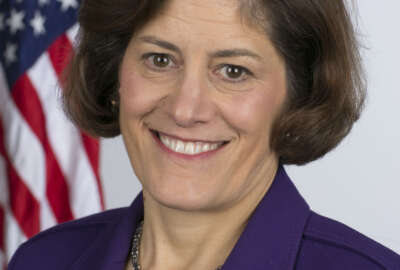
Merit system principles are an asset, not liability in marketing federal careers, OPM says
Acting Office of Personnel Management Director Beth Cobert said agencies should include merit system principles, the rules and procedures that ensure objectivity in...
In recruiting and hiring a diverse pool of new talent, some agencies could use a few branding and marketing lessons to better sell public service to the next generation.
And merit system principles, the rules and procedures that ensure objectivity in the federal hiring — and firing — process, should be a part of agencies’ strategic efforts to recruit and retain that top talent, said Beth Cobert, acting director of the Office of Personnel Management. Those values are the bedrock that makes the civil service “so special,” she said.
“These principles, done right, enable us to bring in the highly qualified talent we need,” Cobert said during a Nov. 29 speech at the HCMG Conference in Alexandria, Virginia. “They mean that anybody with qualifications for a particular position can be considered and that we welcome applicants from every community in this nation. These principles have stood the test of time. The challenge for all of us going forward is how we adapt these principles and the processes we put in place to support them to a different 21st-century world.”
Merit system principles are an asset, not a liability, to federal service, Cobert added, and agencies shouldn’t overlook them. Instead, they should actively talk about those core values.
Yet some agencies may not always see those principles in that light. It’s certainly a challenge that Kevin Mahoney, chief human capital officer for the Commerce Department, has encountered.
“Every one of those merit system principles really is an indicator to someone of why you would want to work for an organization,” he told Federal News Radio. “There’s nothing about them that says, ‘Don’t come here.’ Yet I find sometimes when we’re trying to make a decision on some facet of human resources that people will pull the merit system principles out and say, ‘It says here you can’t do this.’ That stops us from being creative and innovative from time to time.”
OPM has spent the past year pushing hard for agencies to develop more strategic plans to reach out and recruit new employees. The agency has spent the last year traveling to field offices across the country to better educate hiring managers and human resources specialists about existing federal authorities. OPM went to 45 agencies in 22 cities to train 1,085 people under its Hiring Excellence campaign.
Some agencies are beginning to catch on.
Immigration and Customs Enforcement, for example, has a specific outreach program with high schools, colleges and universities.
“It’s expanding who you are,” said Joe Arata, chief of strategic recruitment for ICE. “It’s that famous word ‘branding.’ When I tell people I work for ICE, they all look at me like I have four heads, because our brand isn’t really out there. But if I told people I worked for the FBI, they’d all know who I was.”
Now, when Arata’s team posts an announcement for a criminal investigations job, the agency receives nearly 25,000 applications in the first 24 hours after the post has gone live.
ICE also stood up a community relations office, whose employees attempt to explain what the agency does and dispel bad press.
“It’s a tough road to run up to sometimes when you’re trying to recruit,” Arata said. “We have community relations officers now who are in the communities we serve who talk about what we do, some delicate issues, some political issues. But they are our best avenue to get into communities, into high schools and colleges, church groups and civic organizations, and let us go talk about not just who ICE is but what we do and what the career opportunities are.”
The National Institute of Health is also finding some success in strategically honing its brand.
Debra Chew, the director of the NIH Office of Equity, Diversity and Inclusion, realized her organization needed a new outreach strategy when she came to the agency and saw that half of the senior positions within her office were vacant.
She’s spent the past four years learning what aspects of her office’s “employer brand” she could control and what she couldn’t. Chew said her office discussed their values and actively publicized them to potential and existing employees.
“Your value proposition is a tool that you can use to speak your voice about the commitment that your organization has to diversity,” she said. “Diverse talent is very interested in knowing and understanding that before they would accept an opportunity in an organization or even consider applying to that organization. It’s a way for you to craft your diversity message.”
Strategic planning within the HR workforce
The human resources workforce itself is also shifting toward a more strategic mindset, as agencies begin to move more transactional HR work to a shared services environment.
The Commerce Department’s human resources shop spent nearly 35 percent to 40 percent of its time answering questions related to transactions that the office processed.
“That’s a lot of time that could be spent being more strategic, helping our customers solve their problems in a more creative way,” Mahoney told Federal News Radio. “When we took a look at how we were spending our time and what we were doing, we came to the decision that it was best to take those transactional activities, give them to a vendor to do and create an organization that would focus on the strategic side of it.”
That means that many of Mahoney’s existing employees will need to learn new skills to take on this new kind of human resources work.
“There’s no question that people will have different jobs,” he said. “That was part of the competency assessment that we did to understand what people’s strengths are and where there were training opportunities for them. The next phase of this will be to sit down with them and identify new jobs for them in this new organization.”
Commerce has been working on this project for the past 2 1/2 years or so, Mahoney said. He expects it will take another few years before employees in his HR office are working in their new capacities.
Mahoney said the department is committed to making sure that its existing HR employees continue to have jobs in the agency. Commerce is “getting close” to developing what specific strategic work those employees will need to tackle, he added.
“In all probability, people will be in jobs that might feel a little different to them,” Mahoney said. “There’s still a body of knowledge that applies whether you’re doing strategic work or transactional work, and that will be helpful to people. But by and large, we’ll be looking to broaden people’s skills in partnering with their customers to solve their problems, and that does feel different to people.”
Copyright © 2025 Federal News Network. All rights reserved. This website is not intended for users located within the European Economic Area.
Nicole Ogrysko is a reporter for Federal News Network focusing on the federal workforce and federal pay and benefits.
Follow @nogryskoWFED
Related Stories





